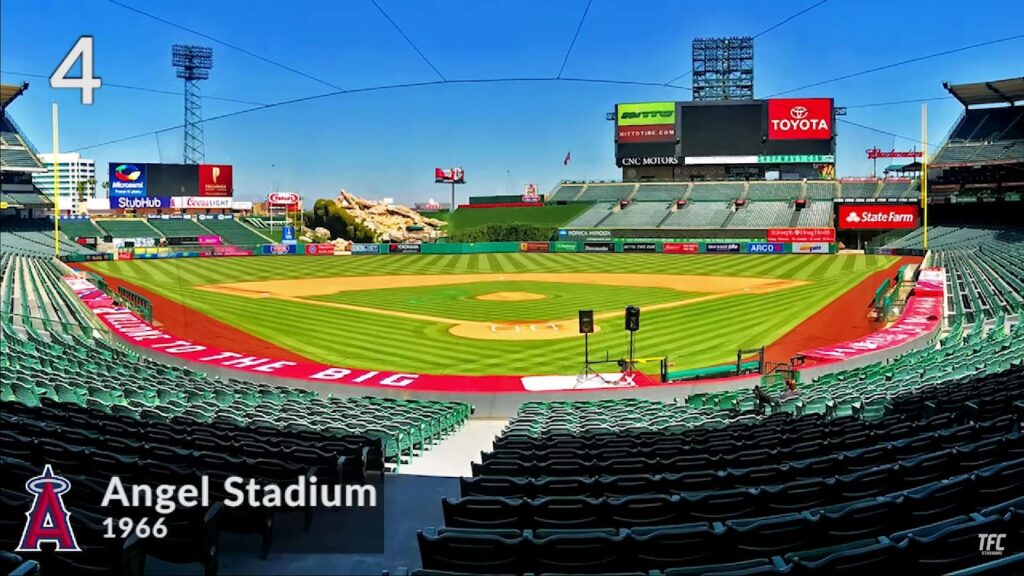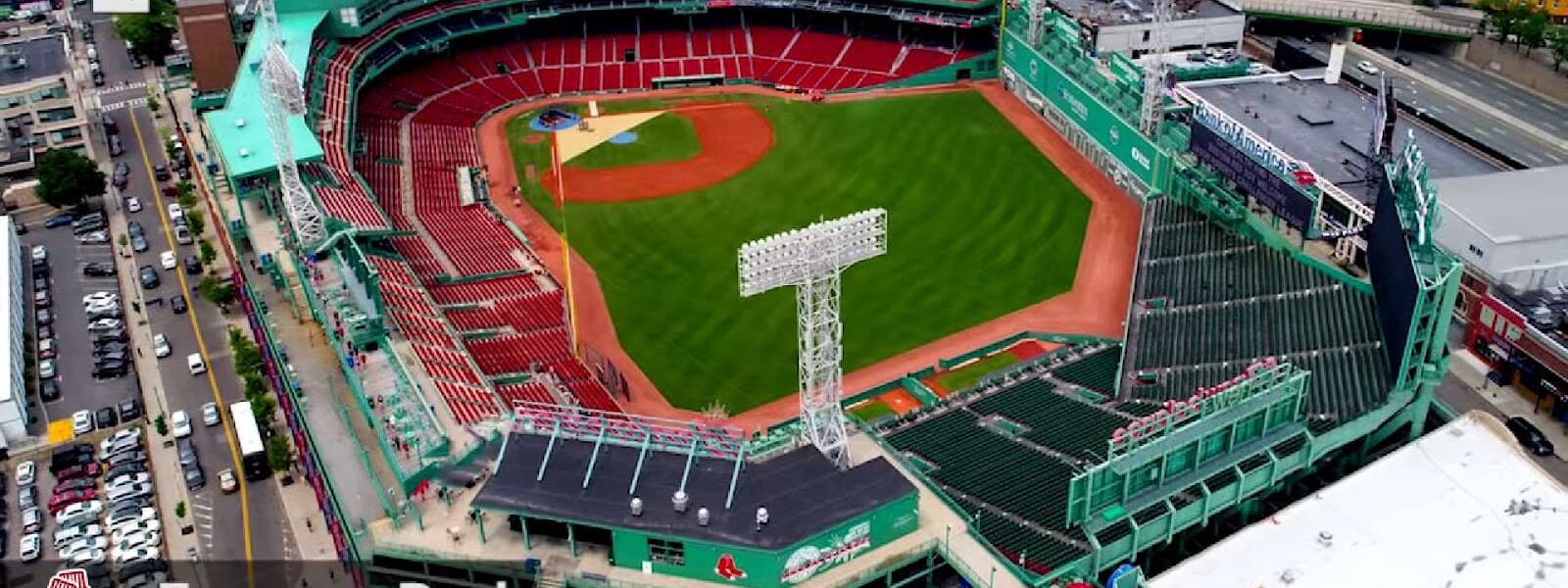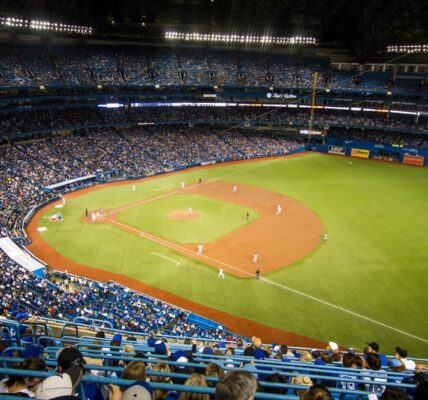Embark on a journey through time as you explore the most ancient stadiums in Major League Baseball’s storied history. These venerable ballparks, which continue to host games to this day, offer a nostalgic voyage through the rich tapestry of America’s beloved pastime.
Discover the Magic of Fenway Park: Baseball’s Oldest Active Stadium
Situated in the heart of Boston, Massachusetts, Fenway Park, represents a treasured slice of baseball history. Proudly the homeground of the Boston Red Sox, this charming stadium has been a focal point of the American League since its construction in 1912. The stadium was designed and built with a revered Jewel Box style, and despite multiple renovations, it maintains its historical essence and design integrity.
In recognition of its historical and cultural significance, Fenway Park was designated a National Landmark during its centenary celebrations. This antique stadium, now over 100 years old, continues to impress visitors with its distinctive and enduring charm.
Unique Features of Fenway Park
Fenway Park is replete with unique characteristics and design quirks that contribute to its rich history:
- Pesky’s Pole: This renowned pole located in the right field, at a distance of 302 feet from the home plate, plays a significant role in Fenway’s unique dimensions;
- The Green Monster: A towering left-field wall, known as the Green Monster, adds a unique challenge for players and an exciting spectacle for fans;
- The Triangle: The furthest point from home plate in the outfield, situated at 420 feet, is an area aptly referred to as the Triangle.
These unique features, among others, make Fenway Park a ground of intrigue and excitement for baseball fans and players alike.
Design and Capacity
Fenway’s seating capacity is 37,755 for night games, with some reductions for day games. The stadium’s seating arrangement preserves a historical ambiance with the oldest wooden seats in Major League Baseball. To improve visibility during day games, some seats are covered to create a better batter’s eye.
Despite its compact size and some minor discomforts associated with its antique seating, loyal fans of Fenway Park cannot resist its historical allure and lively ambiance. The proximity to decades of baseball history and the unique features like the Green Monster add to its charm and appeal.
Tips for Visiting Fenway Park
Visitors planning to experience Fenway Park should consider the following tips for a smoother and more enjoyable visit:
- Transportation: Due to limited parking availability and the stadium’s central location, public transportation is highly recommended for visitors;
- Stadium Tours: The highly rated ballpark tours are an informative and entertaining way to delve into Fenway’s rich history and unique features;
- Concerts: Despite less-than-optimal acoustics, the historic ambiance of Fenway Park makes concerts held here a memorable experience.
There is much to be appreciated about Fenway Park. It is not just a venue for baseball games; it’s an immersive historical experience that takes visitors back to the old days of the sport. The stadium has received high praise for its ability to preserve its iconic character while providing a high-quality gameday experience for all.
Delving into the Timeless Appeal of Wrigley Field: The Second Oldest Baseball Stadium
Recognized as an iconic piece of baseball history, Wrigley Field stands proudly in the northern part of Chicago, Illinois. The stadium was originally erected in 1914 as the home field for the Chicago Whales belonging to the defunct Federal League. However, since 1916, it has been the bastion of the Chicago Cubs after the dissolution of the Whales and their league in the previous year. From 1916 to 1926, it bore the moniker of Cubs Park before being renamed in honor of William Wrigley Jr., the chewing gum tycoon and patron of the team.
Wrigley Field showcases the distinctive Jewel Box design archetype, featuring an open-air roof and a natural grass playing field. This vintage stadium, while not ostentatiously large, comfortably accommodates 41,649 spectators. It further boasts a centerfield wall located at a sizable distance of 400 feet from home plate. Unique and charming features of the stadium include a manually operated scoreboard and the outfield walls festooned with lush ivy.
Stepping Back in Time at Wrigley Field
Wrigley Field’s old-world charm and historic appeal are often lauded by visitors who feel like they are stepping back in time upon entering the stadium. The sentiment of reverence for the venue’s age echoes among fans who relish the purity and tradition of the game experienced here.
- Stadium Tours: Stadium tours, which are highly recommended by visitors, offer in-depth insights about the legendary history of Wrigley Field. These tours provide exclusive access to rarely seen areas such as locker rooms and the press box. They also offer close-up views of iconic features like the ivy-draped walls;
- Facilities: Although Wrigley Field has historic attributes, it is complemented with well-maintained facilities and attentive service staff;
- Neighborhood Vibes: Wrigleyville, the vibrant neighborhood in which the stadium is located, enhances the overall visiting experience, offering a lively atmosphere teeming with off-field entertainment options.
Even as the stadium undergoes updates to blend vintage charm with modern amenities, fans opine that it has retained much of its nostalgic appeal while some purists feel a hint of its old-world allure has faded. Nonetheless, Wrigley Field remains to be cherished as a timeless entity that has preserved its unique charm. For baseball aficionados, this field is not just another baseball stadium – it symbolizes the enduring allure of the sport, making it a must-visit destination.
Unearthing the Charm of Dodger Stadium: The Third Oldest Baseball Stadium
Dodger Stadium, standing tall in Los Angeles, California, is the third oldest working baseball stadium. Construction finished in 1962, coinciding with the Dodgers’ momentous move from Brooklyn to Los Angeles.
An imposing edifice, the Dodger Stadium is the proud holder of the largest official capacity among baseball stadiums. It can host a whopping 56,000 fans, all cheering in unison for the Los Angeles Dodgers. As an open-air baseball field with a manicured grass playing surface, it is a testament to traditional baseball aesthetics.
The Iconic Appeal of Dodger Stadium
Dodger Stadium, over the decades, has acquired a rich legacy. It has borne witness to:
- 10 World Series: These have been action-packed games that have each added a page to the annals of baseball history;
- 12 no-hitters: These games represent the pinnacle of pitching performance, each a testament to the skill and tenacity of the players.
In addition to the baseball games, the Dodger Stadium has opened its doors to a variety of other events. Soccer matches, boxing bouts, cricket games, and rock concerts have echoed within its walls, demonstrating the versatility of this historic venue.
During its years of existence, the stadium has undergone several renovations. One significant change was the relocation of the home plate, which resulted in centerfield now sitting at a distance of 395 feet. Read about the art and precision behind the ultimate baseball hit – a game-changer in your baseball journey. Explore ‘Hit in Baseball’ today!
Fan Experiences at Dodger Stadium
Fans of baseball cherish the captivating charm and vibrant atmosphere of Dodger Stadium. For many, the fascinating views from the stadium and the thrill of participating in the enduring history of Dodgers makes the experience special and unforgettable.
- Maintenance: Despite its extensive history, the stadium is meticulously maintained. It continues to ensure an enjoyable game day experience for all attendees;
- Navigation: Some visitors voice concerns about finding their seats and managing exit traffic due to the older infrastructure of the stadium. However, a majority of them appreciate the dedication and diligence of the staff who help them navigate these challenges;
- Transportation: To mitigate issues associated with traffic, many fans opt for public transportation. The Dodger Express Shuttle system is particularly popular for providing a smooth and hassle-free experience.
Despite a few inevitable challenges due to its age, Dodger Stadium overwhelmingly captivates fans with its rich baseball legacy and vibrant culture. It stands out as a valuable piece of baseball history and a must-visit destination for every baseball enthusiast.
Unveiling the Legacy of RingCentral Coliseum: Home of the Oakland Athletics
The RingCentral Coliseum, popularly known as the Oakland Coliseum, is a multipurpose stadium erected in 1966. Nestled in Oakland, California, it serves as the home ground for the Major League Baseball team, the Oakland Athletics. The stadium has also played host to the Oakland Raiders, a National Football League team, before their relocation to Las Vegas.
With a seating capacity of 46,847 for baseball games, the Coliseum can accommodate over 60,000 spectators when it plays host to other sports. The lush green field of the Coliseum bears the name of Rickey Henderson, the Hall of Famer who had an illustrious career with the Athletics.
The Rich History and Fan Experience at RingCentral Coliseum
Despite its age and some criticisms, the Oakland Coliseum is well-loved by fans for its deep-seated history and accessible ticket prices. Particularly intriguing to visitors are the nostalgic elements present throughout the Coliseum, including memorabilia from past games, which provide a tangible connection to the venue’s illustrious past.
However, not all reviews of the stadium are glowing. Some aspects of the Coliseum, such as the condition of the concourse and other amenities such as the restrooms, receive mixed reviews. Nevertheless, the intimate setting of the stadium and its old-world atmosphere are largely appreciated by guests.
Fans gravitate towards the sense of community nurtured within the Coliseum’s confines. They value the quintessential old-school baseball experience it delivers, even as they hope for improvements in the concessions and enhancements in the facilities.
- Navigating Challenges: Some fans express difficulties while navigating large crowds during departure. Consider planning an earlier exit or using public transportation for a smoother experience;
- Culinary Options: Though there may be calls for improved concessions, there are still popular culinary options like the hot dogs and garlic fries that fans generally appreciate.
In spite of its imperfections, the overall sentiment among fans is a tender nostalgia for the stadium’s charm and history. There is a resounding desire to see the venue retain its identity while going through necessary upgrades.
Exploring the History of Angel Stadium: Home of the Los Angeles Angels
Angel Stadium, nestled in Anaheim, California, opened its gates in 1966 as the homeground of the Los Angeles Angels. With a seating accommodation of 45,050 spectators, it gives an intimate feeling to fans while watching the games. The open-air playground, a standard of classic baseball stadiums, extends up to 396 feet to the centerfield fence.

Upon entering the stadium, visitors are greeted by two gigantic Angel-themed helmets, setting the tone of the baseball fanfare ahead. The picturesque view of the Santa Ana Mountains visible from the stadium adds to the unique charm of Angel Stadium.
The Exceptional Fan Experience at Angel Stadium
Angel Stadium, revered for its rich history and fan-friendly atmosphere, is deemed as one of the most enjoyable places to watch baseball. Embodying an ambiance that is a heartening blend of the old and the new, the stadium has successfully managed to retain its classic essence while keeping up with modern upgrades.
- Dining Offers: Unlike several other vintage stadiums, Angel Stadium boasts an impressive range of food and beverage options to satiate the appetite of the most discerning fans. From classics like hot dogs and popcorn to a diverse array of craft beers, the culinary offerings cater to all types of palates;
- Family-Friendly Entertainment: The stadium goes beyond just baseball, providing an entertainment-rich experience for the entire family. With dedicated kid-friendly zones replete with interactive games and areas for kids to run about, it’s the perfect place for a family outing;
- Sports Memorabilia: For those inclined towards history, the stadium houses a rich collection of sports memorabilia that gives a glimpse into the illustrious past of the Angels.
Through the years, Angel Stadium has undergone multiple renovations to enhance the fan experience. These include updating the scoreboards, revamping the sound system, and improving lighting. Despite these changes, it continues to hold on to its historic charm that fans adore. The overwhelming sentiment among fans is that Angel Stadium offers a delightful baseball viewing experience that combines modern amenities with historic nostalgia.
Discover the Enigmatic Charm of Tropicana Field: Home to the Tampa Bay Rays
Constructed in 1990 in St. Petersburg, Florida, Tropicana Field is a modern wonder that houses the Tampa Bay Rays. This structure stands out as the only fixed-dome stadium in the league, granting fans a reprieve from Florida’s notorious heat and sudden downpours. Tropicana Field is distinctive with its artificial turf field that stretches 404 feet to the fence in dead center.
Appreciating the Unique Attributes of Tropicana Field
Tropicana Field, despite its relatively recent construction, wears its unique attributes like badges of honor. Its dome, once a staple of the 80s and 90s stadiums, now stands unchallenged as the sole survivor of its kind. This, coupled with its classic features, has endeared it to many fans.
- The Rays Tank: An outstanding feature of this stadium is the Rays Tank, which houses live cownose rays. This fascinating exhibit offers interactions and a unique educational experience for visitors;
- Culinary Variety: Tropicana Field sets the bar high with its wide array of food offerings. From traditional stadium fare to local favorites, there’s something to cater to everyone’s preferences.
Although some observers may comment on its lack of modernity, many fans hold a deep respect for the concerted efforts to preserve the stadium’s distinct character. Regardless of its age, the stadium exudes an undeniable charm that infuses the ambiance with a hint of nostalgia and a nod to baseball’s history. It is the unique blend of Tropicana Field’s classic quirks and the comfort it offers from Florida’s climate that makes it an alluring destination for baseball aficionados.
Conclusion
In conclusion, delving into the annals of Major League Baseball’s oldest stadiums is akin to stepping back in time. These enduring ballparks, which continue to grace the baseball landscape, serve as cherished relics that connect us to the deep-rooted history of America’s favorite pastime.




